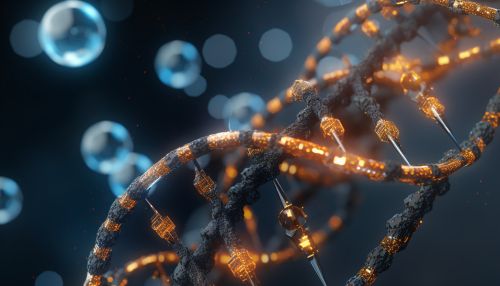DNA Damage
Introduction
DNA damage refers to changes introduced to the deoxyribonucleic acid molecule that alter the sequence of nucleotides. The types of damage can range from single-strand breaks, double-strand breaks, to chemical modifications of the bases. DNA damage can occur naturally due to environmental factors or can be induced by external agents.


Causes of DNA Damage
DNA damage can be caused by both endogenous and exogenous factors. Endogenous factors include reactive oxygen species (ROS) produced during normal metabolic processes, replication errors, and spontaneous hydrolysis. Exogenous factors include ultraviolet (UV) light, ionizing radiation, and certain chemicals.
Endogenous Factors
Reactive oxygen species (ROS) are a byproduct of normal cellular metabolism. They can cause DNA damage by oxidizing the DNA bases, leading to the formation of DNA adducts and DNA strand breaks.
Replication errors can also lead to DNA damage. During DNA replication, the DNA polymerase can make mistakes, leading to the incorporation of incorrect bases. These errors can lead to mutations if not corrected by the DNA repair machinery.
Spontaneous hydrolysis can cause deamination of DNA bases, leading to the formation of uracil, hypoxanthine, and xanthine. These altered bases can lead to mutations if not repaired.
Exogenous Factors
Ultraviolet (UV) light can cause DNA damage by inducing the formation of pyrimidine dimers. These dimers distort the DNA helix and can lead to mutations if not repaired.
Ionizing radiation can cause DNA damage by inducing the formation of free radicals. These free radicals can cause DNA strand breaks and base modifications.
Certain chemicals, such as alkylating agents, can also cause DNA damage. These agents can add alkyl groups to the DNA bases, leading to the formation of DNA adducts.
Types of DNA Damage
There are several types of DNA damage, including single-strand breaks, double-strand breaks, and base modifications.
Single-Strand Breaks
Single-strand breaks (SSBs) are a type of DNA damage where the phosphate backbone of one of the DNA strands is broken. SSBs can be caused by reactive oxygen species, ionizing radiation, and certain chemicals.
Double-Strand Breaks
Double-strand breaks (DSBs) are a type of DNA damage where both strands of the DNA molecule are broken. DSBs are considered the most severe type of DNA damage as they can lead to chromosomal rearrangements and cell death if not repaired.
Base Modifications
Base modifications are a type of DNA damage where the chemical structure of the DNA bases is altered. This can be caused by reactive oxygen species, ionizing radiation, and certain chemicals. Base modifications can lead to mutations if not repaired.
DNA Damage Response
The DNA damage response (DDR) is a complex network of cellular pathways that detect and repair DNA damage. The DDR includes the cell cycle checkpoint pathways, the DNA repair pathways, and the apoptosis pathways.
Cell Cycle Checkpoints
The cell cycle checkpoints are a part of the DDR that ensures that cells with DNA damage do not divide until the damage is repaired. The checkpoints are located at the G1/S, S, and G2/M phases of the cell cycle.
DNA Repair Pathways
The DNA repair pathways are a part of the DDR that directly repair the DNA damage. There are several DNA repair pathways, including base excision repair (BER), nucleotide excision repair (NER), mismatch repair (MMR), and double-strand break repair (DSBR).
Apoptosis Pathways
The apoptosis pathways are a part of the DDR that induce cell death in cells with severe DNA damage. Apoptosis is a form of programmed cell death that helps to prevent the accumulation of cells with DNA damage that could potentially become cancerous.
Consequences of DNA Damage
If not repaired, DNA damage can lead to mutations, which can alter the function of genes and lead to diseases such as cancer. DNA damage can also lead to cell death, which can contribute to aging and neurodegenerative diseases.
